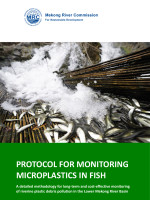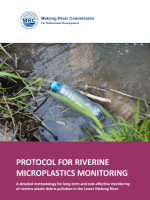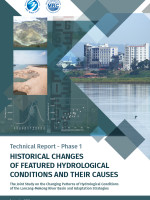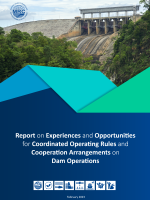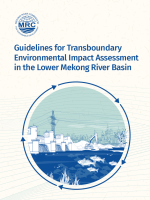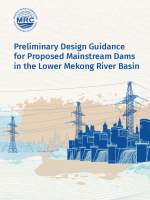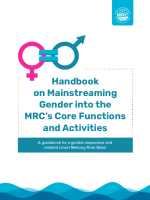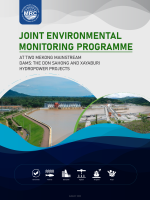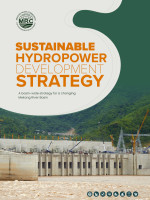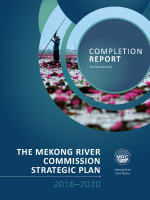Publications related to Hydropower
Protocol for Microplastic Monitoring in Fish
A detailed methodology for long-term and cost-effective monitoring of riverine plastic debris pollution in the Lower Mekong River Basin
With a recent study identified the Mekong River as one of ten rivers to contribute over 90% of plastic debris to the world’s marine environment, there is an urgent need for a reliable data and information on riverine plastic debris pollution and their impacts to the aquatic environment of Mekong River. This Protocol for Monitoring Microplastic in Fihs has been developed and finalized as one of three protocols of the MRC’s Detailed Methodology for the Long-term and Cost-effective Monitoring of Riverine Plastic Debris Pollution in the Lower Mekong River Basin (LMB). The finalization of the detailed methodology was made possible through the concerted efforts and commitment of the MRC Member Countries and support of experts at national, regional and global levels, and included rigorous processes of consultations, capacity building, and piloting to ensure that the methodology is adapted to the situation of the LMB. The methodology aims to provide the much-needed data and information for an improved knowledge and understanding on the pathway and behaviors of plastic debris pollution in the LMB, from land-based sources to riverine environment, and ultimately to the marine environment. Information derived from the long-term implementation of methodology can be used to assess the effectiveness of plastic waste management the LMB.
Download | DOI: 10.52107/mrc.bhv7va | Published on: 19 Jan 2024 | Language: English
Protocol for Riverine Microplastics Monitoring
A detailed methodology for long-term and cost-effective monitoring of riverine plastic debris pollution in the Lower Mekong River
With a recent study identified the Mekong River as one of ten rivers to contribute over 90% of plastic debris to the world’s marine environment, there is an urgent need for a reliable data and information on riverine plastic debris pollution and their impacts to the aquatic environment of Mekong River. This Protocol for Riverine Microplastic Monitoring has been developed and finalized as one of three protocols of the MRC’s Detailed Methodology for the Long-term and Cost-effective Monitoring of Riverine Plastic Debris Pollution in the Lower Mekong River Basin (LMB). The finalization of the detailed methodology was made possible through the concerted efforts and commitment of the MRC Member Countries and support of experts at national, regional and global levels, and included rigorous processes of consultations, capacity building, and piloting to ensure that the methodology is adapted to the situation of the LMB. The methodology aims to provide the much-needed data and information for an improved knowledge and understanding on the pathway and behaviors of plastic debris pollution in the LMB, from land-based sources to riverine environment, and ultimately to the marine environment. Information derived from the long-term implementation of methodology can be used to assess the effectiveness of plastic waste management the LMB.
Download | DOI: 10.52107/mrc.bh5hvu | Published on: 19 Jan 2024 | Language: English
Technical Report – Phase 1 of the Joint study on the Changing Patterns of Hydrological Conditions of the Lancang-Mekong River Basin and Adaptation Strategies
This is the 1st phase report of the Joint Study on the Changing Pattern of Hydrological Conditions of the Lancang-Mekong River Basin and Adaptation Strategies, conducted by the MRC and LMC Water Center. The report identifies two key factors that contribute to hydrological changes in the LMB. First are natural factors, including precipitation patterns, evaporation rates, soil properties and topography. Second are human activities, such as infrastructure development, water management, land cover and land-use changes. These two factors interact and influence the amount, timing and water distribution within the Basin.
Download | DOI: 10.52107/mrc.bd0zhw | Published on: 05 Oct 2023 | Language: English
Report on Experiences and Opportunities for Coordinated Operating Rules and Cooperation Arrangements on Dam Operations
(i.e. This Annual Mekong Flood Report 2015 discusses lessons learned
The report highlights beneficial opportunities for coordinated water
infrastructure operation mechanisms across the cooperation continuum – from coordination (information sharing) through collaboration (adaptation of operations) to joint action
(mutually advantageous planning, design and operations). It provides recommended actions and a forward plan to develop: “Coordinated water infrastructure operation mechanisms for multiple benefits, including gender and vulnerability-sensitive disaster mitigation and management”, as set out in the MRC Strategic Plan 2021–2025.
Download | DOI: 10.52107/mrc.b193up | Published on: 27 Feb 2023 | Language: English
Guidelines for Transboundary Environmental Impact Assessment in the Lower Mekong River Basin (TbEIA)
The Guidelines for Transboundary Environmental Impact Assessment in the Lower Mekong River Basin (TbEIA) is designed as a flexible document with perspective of its further elaboration based on gradually accumulated experience of Member Countries with a TbEIA application. It is also designed as a supporting tool applicable with respect to the different national EIA legislation systems in Member Countries. It builds on and supplements five MRC procedures, including the Procedures for Notification, Prior Consultation and Agreement; Procedures for Data and Information Exchange and Sharing; Procedures for Water Use Monitoring; Procedures for Maintenance of Flows on the Mainstream, and Procedures for Water Quality in addressing potential transboundary environmental impacts of development projects.
Download | DOI: 10.52107/mrc.aqrsbk | Published on: 20 Feb 2023 | Language: English
Preliminary Design Guidance for Proposed Mainstream Dams in the Lower Mekong River Basin (PDG)
The new Preliminary Design Guidance is an updated version of the original PDG introduced in 2009. It incorporates not only what the MRC Member Countries have learnt from their own experience with hydropower, but also from examples and best practices around the world. It also includes the most current knowledge regarding design criteria, science and technology. While the older PDG spanned this range of construction and operation elements (hydraulics; sediment transport; geomorphology; water quality; aquatic ecology; fish and fisheries; dam safety; and navigation), the new PDG now includes hydrology and socio-economic impact to reflect the greater attention paid today to riparian communities and riverine livelihoods.
Download | DOI: 10.52107/mrc.ajutqi | Published on: 20 Feb 2023 | Language: English
Handbook on Mainstreaming Gender into the Mekong River Commission’s Core Functions and Activities: A Guidebook for a Gender-Responsive and Resilient Lower Mekong River Basin
The Handbook for Gender Mainstreaming into the MRC Core Functions and Activities offers a supporting tool – or a guiding note – to assist the MRC to effectively integrate a gender perspective into all aspects of its work, from the development, update and application of strategic tools, procedures, normative guidelines, studies, and organizational strengthening to designing and advocating for joint actions. It also provides a working aid to integrate gender perspectives during the course of the BDS 2021–2030 and SP 2021-2025 implementation, and beyond
Download | DOI: 10.52107/mrc.ajutqn | Published on: 30 Dec 2022 | Language: English
Joint Environmental Monitoring Programme at Two Mekong Mainstream Dams: The Don Sahong and Xayaburi Hydropower Projects
The report provides an overview of activities conducted and resulting recommendations from monitoring two mainstream dams: Don Sahong and Xayaburi hydropower projects. It summarizes the pilot monitoring results from the first pilot site report for each hydropower project and the Combined Annual Report in a way that illustrates how findings in hydrology, sediment, water quality, aquatic ecology, and fisheries can be interpreted together. Based on the findings, it provides some initial suggestions for mitigation and adaptive management of construction and operation of hydropower projects. It also concludes with recommendations for revisions to the guidelines and monitoring protocols that can then be incorporated into the JEM Programme document.
Download | DOI: 10.52107/mrc.aqrs7o | Published on: 19 Aug 2022 | Language: English
Sustainable Hydropower Development Strategy: A Basin-wide Strategy for a Changing Mekong River Basin
The Sustainable Hydropower Development Strategy 2021 presents the MRC’s approach toward mega infrastructure project development including hydropower projects in the Lower Mekong River Basin. It provide a framework for how to “avoid, minimize and mitigate” the transboundary impact of hydropower projects. It defines three strategic areas for the MRC to work on: Consideration of Integrated Water Use, Environmental and Socio-economic Factors; Efficient Hydropower Generation and Distribution Mechanisms; and finally, Information System and Capacity Building.
Download | DOI: 10.52107/mrc.ajutpe | Published on: 20 Jun 2022 | Language: English
Completion Report for the MRC Strategic Plan 2016–2020
Achievements the Completion Report 2016–2020 presents the MRC’s key
Achievements in terms of the completion of outputs, the achievements of outcomes and financial performance during the five-year implementation of the MRC Strategic Plan 2016–2020 and its Annual Work Plans. It also includes the lessons learned from that period, and how they formed the basis of the next planning cycle – the Basin Development Strategy 2021–2030 and the MRC Strategic Plan 2021–2025.
Download | DOI: 10.52107/mrc.qx5ynu | Published on: 23 Jul 2021 | Language: English
